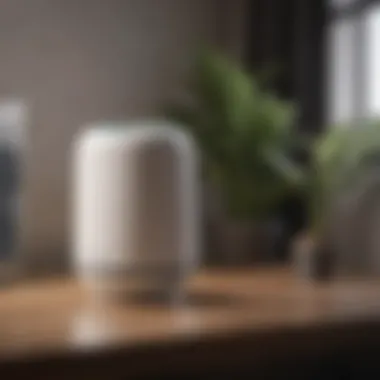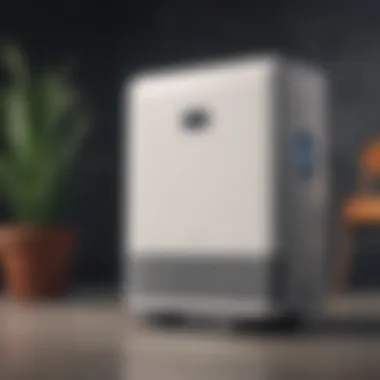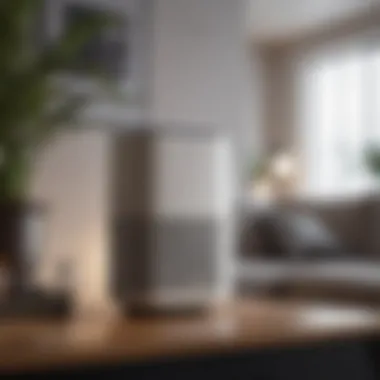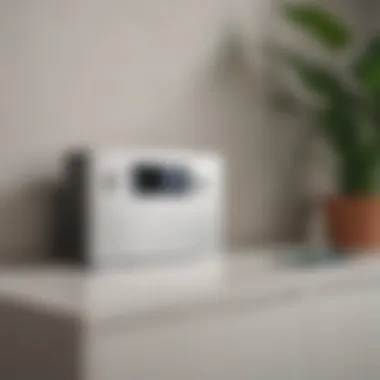Top Air Purifiers for Small Rooms Reviewed


Intro
In contemporary living spaces, indoor air quality is crucial, especially in small rooms where air circulation might be limited. With pollutants such as dust, allergens, and volatile organic compounds (VOCs) affecting our health, choosing the right air purifier becomes vital. This guide will provide insights into the best air purifiers designed specifically for compact environments, ensuring that you can breathe easy and maintain a healthy atmosphere in your home. We will discuss key features, effectiveness, and considerations when selecting an appropriate device.
Design Inspiration
Current Trends in Interior Design
Air purifiers are no longer merely functional devices hidden in corners. They have evolved along with the trends in interior design. Modern air purifiers now feature sleek and stylish designs, making them an integral part of home decor. Homeowners look for units that can blend seamlessly with their interior while delivering optimal performance.
A popular trend is the use of minimalist designs that fit discreetly into various settings. Many brands focus on creating airflow systems that are visually appealing and compact. Brands like Dyson and Coway have developed designs that can serve as conversation starters, harmonizing visibility and efficiency.
Color Schemes and Palette Ideas
Choosing the right color for an air purifier can have a significant impact on the overall decor of a room. Muted colors such as white or light grey are often preferred for a more elegant and modern look. They can easily match with various color schemes, regardless of the room's existing palette. However, some users may opt for bolder colors to create a focal point. Brands now offer customizable options, allowing users to select hues that resonate with their personal style. This inclusion of aesthetics allows air purification to become a part of home styling rather than an afterthought.
Features to Consider When Choosing an Air Purifier
When selecting an air purifier for a small room, several factors come into play. Here are the primary features to evaluate:
- Filter Type: The most common are HEPA filters, which capture a high percentage of airborne particles. Activated carbon filters help reduce odors.
- CADR Rating: Clean Air Delivery Rate is a measure of how quickly an air purifier can filter the air in a room. Higher numbers indicate better airflow.
- Noise Level: Air purifiers can generate sound. Some brands prioritize whisper-quiet technology, ensuring that noise does not become a nuisance, especially at night.
- Size and Portability: In smaller spaces, consider the footprint of the unit and if you can move it easily if necessary.
- Smart Features: Integrating smart technology can enhance user experience. Some devices can be controlled via apps, allowing monitoring and adjustments remotely.
Effectiveness in Improving Indoor Air Quality
Choosing an air purifier impacts overall health, especially in small rooms. The efficacy of these devices can vary based on design and features. A high-quality purifier should effectively reduce allergens, smoke, and pollutants, thus improving indoor air quality significantly.
Research indicates that consistent use of air purifiers can lead to noticeable benefits in respiratory health. For people with allergies or asthma, having an efficient air purifier can mitigate symptoms and contribute to a healthier living environment.
"Investing in an effective air purifier is not merely a luxury; it’s a strategic measure to ensure long-term health."
Finale
Selecting the best air purifier for small rooms involves considering design, features, and effectiveness. It is essential to evaluate personal needs and preferences before deciding. The right choice can lead to improved air quality and overall well-being, creating a harmonious and health-oriented living space.
Understanding Air Purification
Air purification is a critical aspect of maintaining a healthy and comfortable environment, especially in small spaces. The quality of air we breathe directly affects our health, comfort, and overall well-being. Understanding air purification not only helps identify the right device for your space but also underscores the need for clean air in our daily lives.
What is an Air Purifier?
An air purifier is a device designed to remove contaminants from the air in a room. These devices typically use various filtration methods to target pollutants like dust, pollen, pet dander, smoke, and volatile organic compounds. By understanding what an air purifier does, one can appreciate its role in enhancing indoor air quality. Different models use specialized filters such as HEPA or activated carbon, which can trap particles and absorb odors, effectively making the air cleaner and more pleasant to breathe.
How Air Purifiers Work
Air purifiers operate on the principle of air circulation. They draw air in from the room, filter it via their internal system, and then release the cleaned air back into the environment. Most commonly, they rely on a combination of physical filters and, in some cases, advanced technologies like ionization or UV light.
- HEPA Filters: These filters capture 99.97% of particles that are 0.3 microns in diameter. This makes them particularly effective against allergens.
- Activated Carbon Filters: These are beneficial for eliminating odors and harmful gases, thanks to their highly porous structure that adsorbs chemicals.
- UV Light: Some purifiers use UV light to kill bacteria and viruses present in the air.
Knowing how these devices work will inform homeowners of their effectiveness for specific air quality issues.


The Importance of Clean Air
Clean air is essential for both physical health and mental well-being. Poor air quality can lead to a range of health issues, including respiratory problems, allergies, and even cardiovascular diseases. Furthermore, clean air can enhance concentration, mood, and sleep quality. Therefore, investing in an air purifier for small rooms is not just about comfort; it is a proactive measure to safeguard one's health.
"Indoor air can be more polluted than outdoor air, making air purifiers a critical asset for maintaining health in confined spaces."
In summary, understanding air purification involves grasping what air purifiers are, the mechanisms behind their functionality, and recognizing the substantial need for clean air. This foundational knowledge equips individuals with the insight necessary to make informed decisions when selecting an air purifier that suits their specific needs.
Types of Air Purifiers
Understanding the different types of air purifiers available is essential when considering the best options for small rooms. Each type has unique characteristics that cater to certain air quality issues. Choosing the right type can significantly enhance air quality, particularly in compact living spaces. Knowing the strengths and weaknesses of each kind can help in making an informed decision, especially for those concerned about allergens, dust, and other pollutants.
HEPA Filters
HEPA (High-Efficiency Particulate Air) filters are widely recognized for their effectiveness in trapping small particles. They can capture up to 99.97% of particles as small as 0.3 microns in size. This includes dust, pollen, pet dander, and even some bacteria. In small rooms, where air circulation is often limited, HEPA filters can make a notable difference in overall air quality.
The advantage of HEPA filters lies in their durability and requirement for minimal maintenance. They do not release contaminants back into the air, making them a safe choice for households with children or pets. Furthermore, while HEPA filters are not effective against gases or odors, they excel in reducing particulate matter, which is crucial for mitigating allergy or asthma symptoms.
Activated Carbon Filters
Activated carbon filters offer a different approach to air purification. They contain activated carbon, a highly porous material that absorbs volatile organic compounds (VOCs), odors, and harmful gases. This type of filter is essential in urban areas or places with significant pollution, as it helps to remove smells from cooking or smoking that can linger in small spaces.
While activated carbon filters do not capture particles like HEPA filters, they complement them well in a multi-stage purification process. It is worth noting that these filters need to be replaced regularly to maintain their effectiveness. Otherwise, they can become saturated and lose their ability to absorb odors and gases.
UV Light Purifiers
UV light purifiers use ultraviolet light to kill bacteria, viruses, and mold spores in the air. By blowing air over a UV lamp, these devices can neutralize biological contaminants. This is particularly beneficial in small rooms, where pathogens can spread quickly in confined spaces.
However, it is important to consider that UV light purifiers require a system to manage the particles themselves. Usually, they are used in combination with HEPA or activated carbon filters for optimal results. Users should also be aware of the need for regular maintenance and bulb replacement, as the effectiveness of UV light decreases when bulbs dim over time.
Overall, selecting the right air purifier type requires consideration of specific needs and factors like the types of pollutants present in your space. Each type has its unique advantages that can greatly enhance indoor air quality in small rooms.
Key Features to Consider for Small Rooms
When selecting an air purifier for small rooms, several key features should be examined closely. The effectiveness, usability, and efficiency of the device are paramount, so understanding these features will help potential buyers make informed decisions.
Size and Portability
The size of an air purifier is crucial for small rooms. A compact air purifier fits easily in limited spaces without becoming an obstruction. Portability is equally important, especially if the user plans to move the device between rooms or areas. Look for models that are lightweight and equipped with built-in handles or wheels. This enhances flexibility, allowing users to optimize air quality wherever it is needed most.
Noise Levels
Noise levels can greatly influence the satisfaction with an air purifier. For small rooms, such as bedrooms or studies, a loud machine can become disruptive, impacting sleep or concentration. Many modern models now prioritize quiet operation. This feature is often measured in decibels (dB), and it is advisable to select a purifier that operates at a sound level comparable to whispers or quiet conversations. A product that offers a night mode may also dim the lights and lower the noise, which is beneficial in creating a serene environment.
CADR Ratings
Clean Air Delivery Rate (CADR) ratings are significant indicators of an air purifier's efficiency. This measure indicates the volume of filtered air delivered by the purifier per minute. For small rooms, a CADR value appropriate to the room size will ensure effective air cleaning. In general, a higher CADR rating suggests better performance. It's essential to align the CADR with the specific dimensions of the space to achieve maximum effectiveness.
Energy Efficiency
Energy efficiency is another critical feature when selecting an air purifier for small spaces. An efficient model uses less electricity, reducing long-term costs. Look for air purifiers that are Energy Star certified, as this can provide assurance of the device’s efficiency. Additionally, consider features like automatic timers or smart sensors that can adjust operation based on air quality, leading to further energy savings.


Evaluating Air Quality Needs
Understanding the specific air quality needs of small rooms is essential for selecting the right air purifier. In confined spaces, the density of airborne pollutants can be significantly higher compared to larger living areas. This necessitates a careful evaluation of the types and levels of contaminants present.
Common Pollutants in Small Rooms
In small rooms, the most frequent pollutants include dust particles, pet dander, pollen, and volatile organic compounds (VOCs). These contaminants often accumulate due to limited airflow and can derive from a variety of sources such as:
- Dust and Allergens: These are common in households, especially if pets are present. Carpets, upholstery, and bedding can harbor dust mites and dander.
- VOCs: Items like paints, furniture, and even cleaning products can release VOCs, which can impact health. Limited ventilation can exacerbate the buildup.
- Mold Spores: In small, humid spaces, mold growth is more prevalent. Mold spores can circulate and are harmful when inhaled.
Being aware of these pollutants helps homeowners identify the necessary filtration systems for their air purifiers. An effective air purifier should target these specific contaminants for optimal indoor air quality.
Health Implications of Poor Air Quality
Poor air quality can lead to several short-term and long-term health issues. In small rooms, where symptoms can worsen due to the concentrated presence of pollutants, the ramifications are especially concerning.
- Respiratory Problems: Exposure to dust mites, mold, and dander can contribute to asthma and allergies. Individuals with existing conditions may experience exacerbated symptoms.
- Cognitive Impact: Studies indicate that poor indoor air quality can affect cognitive function, leading to difficulty concentrating and reduced productivity.
- Long-term Health Risks: Continuous exposure to VOCs can have severe health impacts, including respiratory diseases and other chronic conditions.
"Addressing indoor air quality is not merely about comfort; it's a significant factor in overall health and well-being."
Evaluating these elements aids in understanding what specific features the air purifier must possess. Whether it's a HEPA filter to capture fine particles or activated carbon to absorb VOCs, knowledge about pollutants guides effective choices.
Top Air Purifier Recommendations
The importance of selecting the right air purifier cannot be understated, especially for those living in small rooms. A well-chosen device does not only improve your air quality but also contributes to a healthier living environment. In this section, we will evaluate three prominent models, each catering to different needs and preferences. Understanding the features and performance of each model helps individuals make informed choices based on their specific situations. The right air purifier offers multiple benefits, such as reducing allergens, eliminating odors, and improving overall comfort in limited spaces.
"Investing in an effective air purifier is an investment in your health and well-being."
When selecting an air purifier, key considerations include filter type, room coverage area, noise levels, and additional features like smart connectivity options. Evaluating these factors allows homeowners to align their choices with their unique lifestyle, preferences, and the characteristics of their living spaces.
Model A: Features and Performance
Model A is known for its high-efficiency particulate air (HEPA) filter, which captures at least 99.97% of particles as small as 0.3 microns. This model is designed to be compact, making it ideal for small rooms such as bedrooms or home offices. One of its standout features includes a real-time air quality monitor that gives visual feedback through LED indicators. This helps users understand the current air quality, enabling them to adjust settings accordingly.
The noise level is particularly appealing, operating quietly on its lowest settings, which makes it suitable for night-time use. Moreover, it has a CADR (Clean Air Delivery Rate) of 130 cubic feet per minute, providing efficient air cleaning in rooms up to 200 square feet. Users appreciate its sleek design, which blends well with various interior aesthetics.
Model B: Features and Performance
Model B takes a different approach with its activated carbon filter that is effective at absorbing odors and volatile organic compounds (VOCs). This particular air purifier is also equipped with a built-in UV light that targets bacteria and viruses, enhancing its effectiveness further. The filter is replaceable every six months, ensuring optimal performance.
This model also features a portable design, making it easy to move between rooms. Its CADR rating stands at 150, accommodating small to medium spaces efficiently. Users report satisfaction with its user-friendly interface and variable speed settings that allow for customization based on air quality and personal preference. It operates at a slightly higher noise level, but the benefits often outweigh this minor setback.
Model C: Features and Performance
Model C combines advanced technology with user-friendly features, including smart home integration. This air purifier utilizes a HEPA filter alongside an activated carbon layer, providing comprehensive air cleaning capabilities. The model is designed with an app that offers air quality tracking, filter health notifications, and remote control functionality, adding a modern twist that tech-savvy individuals will appreciate.
With a CADR rating of 180, Model C is well-suited for rooms up to 300 square feet. Its operation is whisper-quiet, making it optimal for environments that require minimal noise, such as nurseries or study areas. Similar to the previous models, its design is compact and aesthetically pleasing, allowing it to fit seamlessly in small spaces.
In summary, each of these recommended models presents unique features and benefits tailored for different air quality needs. By carefully evaluating these options, consumers can find the right air purifier that enhances their home environment while addressing specific air quality concerns.
Pricing Considerations


Selecting the right air purifier for small rooms involves various considerations. One of the most significant aspects is pricing. Understanding pricing not only helps you make an informed decision but also ensures that the investment aligns with your expectations and needs. Key elements to consider include the initial purchase cost and ongoing maintenance costs, both of which can impact your overall satisfaction with the product.
Initial Purchase Cost
The initial purchase cost of an air purifier can vary widely based on features and brand. Generally, you can find models ranging from 50 to several hundred dollars. Higher-end models typically offer advanced filtration technologies, more coverage area, and additional functionalities that may be beneficial for specific needs.
When choosing an air purifier, think about:
- Budget: Set a clear budget. This will help narrow your options while ensuring you do not overspend.
- Features: Identify essential features you want. For example, do you need a HEPA filter? Is energy efficiency key?
- Brand Reputation: Brands like Coway and Dyson can command a premium but may offer better performance and longevity compared to economical options.
In this way, while an air purifier can be an upfront expense, its benefits in terms of health and comfort may justify the expenditure over time.
Maintenance and Filter Replacement Costs
After the purchase, consider ongoing maintenance expenses, primarily filter replacement costs. Most air purifiers require regular filter changes, which can range from 20 to 100 dollars each, depending on the type and model. Regular maintenance is crucial for optimal performance and air quality benefits.
Here are important points regarding maintenance costs:
- Frequency of Replacement: Depending on usage, filters may need changing every 3 to 12 months. Understanding this can help budget appropriately.
- Cost Comparison: Calculate the annual cost of filter replacements against the benefits. This analysis can provide insights into the product's overall value.
- DIY Maintenance vs. Professional Service: Some individuals may choose to handle maintenance themselves, while others may prefer professional help, each impacting budget considerations.
"Proper maintenance enhances not only the lifespan of the air purifier but also its effectiveness in ensuring clean air for your room."
In summary, awareness of the initial purchase cost and maintenance expenses is vital. By being informed about these elements, you can select an air purifier that fits your budget while still meeting your air quality needs.
Questions and Answerss About Air Purifiers for Small Rooms
Understanding common questions about air purifiers is essential for homeowners and enthusiasts interested in improving indoor air quality. This section addresses frequently asked questions, allowing readers to make informed choices regarding air purifiers for small spaces. The goal is to clarify doubts and provide relevant information, ultimately leading to healthier living environments.
Do Air Purifiers Remove Viruses?
Air purifiers vary in their ability to remove viruses from the air. Generally, models equipped with HEPA filters can capture airborne particles, including some viruses, effectively. However, it is essential to note that while air purifiers can reduce the concentration of on airborne contaminants, they do not eliminate them completely from the environment.
Some advanced models, such as those utilizing UV light, enhance virus removal by neutralizing these particles as they pass through the system. It is a good practice to check the specific features of an air purifier to understand its effectiveness against viruses. But it should be remembered no air purifier can act as a substitute for proper hygiene measures, such as regular handwashing and keeping surfaces clean.
“While air purifiers help reduce the presence of viruses, they should be part of a broader strategy for maintaining health.”
How Often Should Filters Be Changed?
The frequency of filter changes depends largely on the model of air purifier and the environment in which it operates. Most manufacturers provide guidelines in their user manuals, which should be consulted. Typically, HEPA filters require replacement every 6 to 12 months. Activated carbon filters might need swapping out more frequently, usually every 3 to 6 months, especially in areas with higher levels of pollutants or odors.
For optimal performance:
- Inspect Filters Regularly: Look for visible dirt, discoloration, or loss of airflow.
- Follow Recommendations: Adhere to manufacturer guidelines to maintain efficiency.
- Monitor Air Quality: Air quality can fluctuate, so adjust the filter change schedule as necessary.
Keeping on top of filter maintenance ensures that the air purifier operates at peak performance, effectively improving indoor air quality in small rooms.
End and Final Thoughts
In the context of selecting an air purifier for small rooms, the conclusion serves not only as a summary but also as a critical reflection on the various elements discussed throughout this article. Choosing the right air purifier is essential for enhancing indoor air quality and ensuring a healthy living environment. The benefits of investing in an effective unit extend beyond mere aesthetics; they include improved respiratory health, reduced allergens, and overall comfort in your space.
A few key considerations arise from the discussions:
- Understanding Your Needs: It's crucial to evaluate your specific requirements based on the pollutants present in your room. For example, those with allergies may focus on HEPA filters that capture particulate matter, whereas others might prioritize activated carbon filters for odors.
- Size and Efficiency: The air purifier's capacity should align with the size of your room. A poorly matched unit may result in inefficiency, negating its intended benefits. The Clean Air Delivery Rate (CADR) is a useful metric here, and should not be overlooked.
- Cost Management: Considering both initial costs and ongoing maintenance expenses is vital. While a higher upfront investment might seem daunting, it can lead to significant long-term savings when factoring in filter longevity and energy efficiency.
- Noise and Aesthetics: While not often deliberated, the noise levels of an air purifier can directly influence your living conditions. Hence, selecting a model that strikes a balance between effective air purification and acceptable noise levels is advantageous.
As with any home appliance, making an informed decision requires diligence. Researching specific models, reading product reviews, and understanding technical specifications will enhance your ability to select the best unit for your needs.
"Air purifiers are not merely a luxury; they are an essential component for maintaining a clean and safe home environment."



